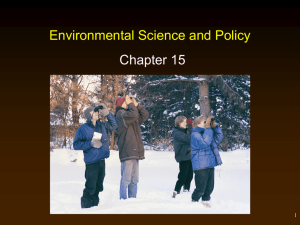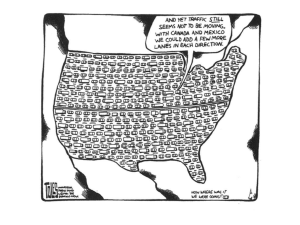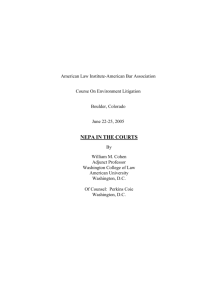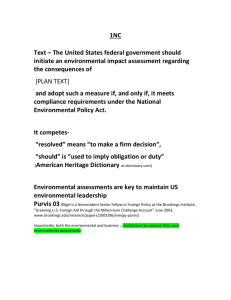Natural Resources Law
advertisement
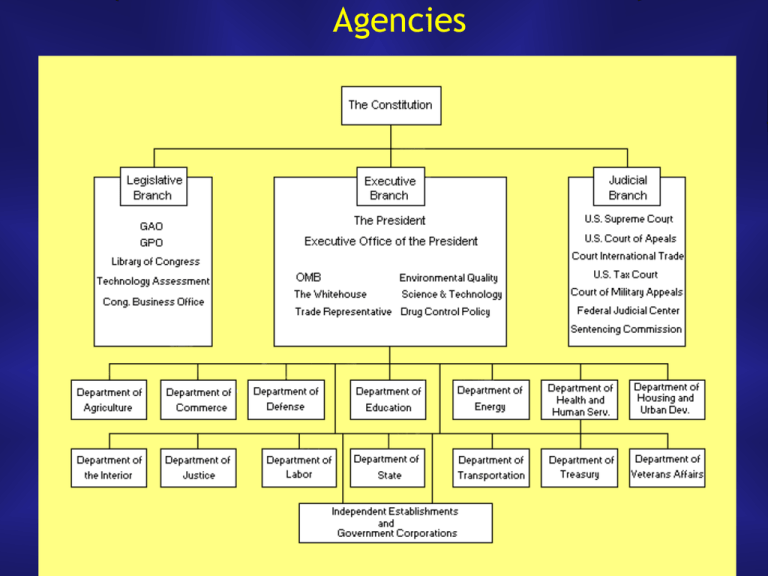
Agencies Department of Agriculture Administrative Agencies • Fourth branch of government – Non-delegation doctrine • Congress must provide an “intelligible principle” to guide the exercise of agency discretion – Agency Action • Rulemaking • Adjudication – Administrative agencies are pervasive in natural resources law • Are there any unifying principles? • How did they evolve? U.S. Forest Service • Division of Forestry at DOI gave way to the USFS in USDA • 155 forests covering 191.6 million acres • Headed by a Chief – Regions headed by Regional Foresters – Forests headed by Superintendents – Districts (within a Forest) headed by District Rangers Forest Service Regions National Forest System • What are the purposes for which forests were established? – 1897 Organic Act • Forest reserves established to “ensur[e] favorable conditions for water flows…” and “to furnish a continuous supply of timber….” • MUSYA of 1960 – Multiple use and sustained yield – Supplemental purposes • RPA of 1975 – Forest system-wide planning • NFMA of 1976 – Land use planning (LRMPs) Bureau of Land Management History of the BLM • The General Land Office – Established in 1812 in Treasury Department to oversee disposition of public lands • U.S. Grazing Service – Established in 1934 under Taylor Grazing Act • In 1946, GLO and Grazing Service were merged to form the BLM in the Department of the Interior • In 1976, Congress passed the Federal Land Policy and Management Act (FLPMA), sometimes called the BLM Organic Act – First time Congress stated a general policy to retain public lands in federal ownership (Provision for sale of lands only after appropriate planning.) FLPMA • Provides for – – Preparation and maintenance of an inventory of public land resources – Land use planning on BLM managed lands (RMPs) • Multiple use/sustained yield principles applied – “Withdrawals” of public land • What’s a withdrawal? – Limited sale and acquisition authority – Exchange authority (equal value) – Right of way authority (FS and BLM) – Wilderness studies for BLM lands • Obligates Secretary to prevent “unnecessary and undue degradation” of the public lands • Establishes mining claim filing requirements • Makes provision for 10-year grazing permits and allotment management plans (AMPs) (FS and BLM) Comparing USFS and BLM • FS cultivates its reputation as an apolitical agency that makes decisions based on science – Gifford Pinchot’s legacy – Agency structure helps to promote this approach – Manages less land than the BLM but has about 6 times the number of employees as the BLM • BLM has historically been more prone to political influence – Example of agency capture (“Bureau of Livestock and Mining”) – Struggles to rid itself of poor public image • National Landscape Conservation System • FS has about 6 times as many employees as the BLM but the BLM manages about 75 million acres more than FS National Wildlife Refuge System (DOI) • Its mission is to administer refuges “for the conservation, management, and where appropriate, restoration of the fish, wildlife, and plant resources and their habitats … for the benefit of present and future generations….” • Nearly 500 units covering about 90 million acres (mostly in Alaska) • Managed by US Fish and Wildlife Service (FWS) • National Wildlife Refuge System Administration Act of 1966 National Park System (DOI) • Park Service Organic Act of 1916 – Establishes the National Park Service (NPS), which manages parks, monuments, etc. “to conserve the scenery and natural and historic objects and the wildlife therein, and to provide for the enjoyment of the same in such manner and by such means as will leave them unimpaired for future generations.” 16 U.S.C. §1. – 368 units (parks, monuments, historic parks, battle fields, etc.) covering about 80 million acres of land (about half of this in Alaska) Other Systems • National Wilderness Preservation System (104 million acres in 44 states) – Wilderness is designated by Congress from the many different types of public lands • Wild and Scenic Rivers System – 150 rivers, 10,734 miles in 34 states • National Trails System – 19 trails covering 35,000 miles Other Agencies • NOAA Fisheries – Dep’t of Commerce • Bureau of Indian Affairs (BIA) – Department of the Interior • Army Corps of Engineers – Department of Defense • USGS – Department of the Interior • Environmental Protection Agency (EPA) • Council on Environmental Quality (CEQ) – Office of the President • Bureau of Reclamation – Department of the Interior • Minerals Management Service (MMS) – Department of the Interior • Office of Surface Mining (OSM) – Department of the Interior Resolving Interagency Disputes • Consider the structure of the Executive Branch • President (or Justice Department can generally resolve disputes among executive branch agencies – What happens when dispute arises between independent regulatory agencies, like the Nuclear Regulatory Commission and an Executive branch agency, such as the Fish and Wildlife Service? Problems of Agency Capture and the Public Interest • Why does agency capture occur? • How does an agency determine the public interest? – Is it a majority vote as Professor Huffman suggests? – Is it in the public interest to allow snowmobiles in Yellowstone National Park? – To allow ski areas in a pristine roadless area of a national forest? Improving Agency Decisionmaking • Administrative Procedure Act (5 U.S.C. § 551 et seq.) – Basic law governing agency decisionmaking – Divides agency action into rules and orders • Rulemaking is the process for developing rules • Adjudication is the process for creating orders – Agencies may choose whether to act by rule or by order • For example, an agency may promulgate a rule requiring certain reclamation work at a mine site, or it may issue a permit and insist on such work, even in the absence of a specific rule Rulemaking • Formal rulemaking is rare and does not generally apply to natural resource decisions – Requires trial type hearing • Informal rulemaking (notice and comment rulemaking) is more common, but it is much more cumbersome than the word “informal” might suggest • Non-legislative rules that follow neither procedure are becoming more common as agency seek ways to avoid cumbersome procedures. These may include, for example – – Legal opinions – Instruction memoranda – Directives – Agency manuals The Complexities of Rulemaking • In addition to the APA, agencies must comply with – – The National Environmental Policy Act (NEPA) • Requires an EIS for major federal actions; an EA for lesser actions – Regulatory Flexibility Act • Requires a RFA for rules with significant impacts on small businesses – Paperwork Reduction Act • Requires agencies to consider and reduce impact of new paperwork requirements – Unfunded Mandates Reform Act • Requires consideration of impact on local and state governments – Exec. Order 12991 • Requires cost-benefit analysis • NOTE: 5 U.S.C. § 551(5) defines “rulemaking” to include the process for “repealing a rule” Adjudication • Formal and informal adjudications • Formal requires a trial-type hearing before an “administrative law judge” • The process for informal hearings is not directly addressed in the APA, but the APA generally allows a person – – to appear before an agency in a proceeding – to receive a decision within a reasonable time, and – if a request made to the agency is denied, to receive a brief statement of the grounds for denial. 5 U.S.C. §555. – These informal procedures are often supplemented by an agency’s own procedures Judicial Review of Agency Action, 5 U.S.C. § 706 (1) compel agency action unlawfully withheld or unreasonably delayed; and (2) hold unlawful and set aside agency action, findings, and conclusions found to be – – (A) arbitrary, capricious, an abuse of discretion or otherwise not in accordance with law; – (B) contrary to constitutional right, power privilege or immunity; – (C) in excess of statutory jurisdiction… – (D) without observance of procedure required by law…. – (E) unsupported by substantial evidence [in formal proceedings] – (F) unwarranted by the facts to the extent that such facts are subject to trial de novo Arbitrary and Capricious Standard • • While the standard is deferential, it requires agencies to take a “hard look” CTOP v. Volpe “Normally, an agency rule would be arbitrary and capricious if – 1. the agency has relied on factors which Congress has not intended it to consider, 2. entirely failed to consider an important aspect of the problem, 3. offered an explanation for its decision that runs counter to the evidence before the agency, or 4. is so implausible that it could not be ascribed to a difference in view or the product of agency expertise.” • Motor Vehicles Mfrs Ass’n v. State Farm Ins. Co., 463 U.S. 29, 43-44 (1983) Agency Interpretations of the Statute it Administers • Chevron test: – For agency interpretations that occur in rulemakings and formal adjudications 1. Is the statute clear? If so, apply the statute. 2. If not, defer to any “permissible,” i.e., reasonable, construction by the agency • Mead/Skidmore test: – – For agency interpretations that occur as a result of less formal processes Lesser deferential standard; court gives the agency’s decision the respect it is due NSO v. Hodel • What was the agency action? • What is the standard of review? Why? • Why did the court rule against the agency? – Consider the deference that courts give agencies as noted by Vic Sher • What was the remedy? The Role of NGOs • http://ga1.org/campaign/stone_tws • http://www.nma.org/policy/regulatory/new_source_revi ew.asp • http://www.suwa.org/page.php?page_name=Camp_2477_ Home • http://www.wyomingoutdoorcouncil.org/alerts/gd032603 .html • http://www.greenscissors.org/news/gs2003pr.html • Note that groups may act as advocates, as think tanks and experts, and as market players Lobbying for Legislative and Administrative Action • Efforts of NGOs may counteract impact of public choice theory – But does it present its own set of public choice problems? – Who speaks for the public? Who defines the public interest? • Is this just another example of public choice theory where two interest groups battle for favor, and the public is still shut out? – Consider that most NGOs do not have economic self interests • What about the National Mining Association? • How do groups overcome income disparity in available resources? Access to Courts • Citizens suits – Citizens act as private attorneys general – Provided by statute • Generally allow suits against violators or agency where agency fails to carry out non-discretionary duty • Citizen plaintiffs may recover legal costs if they win (one-way fee-shifting) – Common in environmental statutes; uncommon in resource statutes • But ESA has a citizen suit provision Access to Courts • Standing to sue – Does a citizen suit provision afford universal standing to citizens who raise issues allowed under the law? – Any constitutional problems with universal standing • Professor Squillace’s standing test – Standing requires a personal, redressable, injury in fact, economic or otherwise, that can be traced to the defendant’s conduct – And if the lawsuit relies on the APA for a waiver of sovereign immunity, the plaintiffs must also show that they are within the zone of interests sought to be protected by the statute Organizational Standing • Hunt v. Washington Apple Advertisers test – One or more of members must have standing in their own right – Relief requested must be germane to the organization’s purpose – Neither the claim asserted nor the relief requested can require participation of individual members • For example, you can’t seek damages for injury to a member’s property Lujan v. Defenders of Wildlife • Who is suing whom and for what? – • Extraterritorial application of ESA §7(a)(2) What is the “irreducible constitutional minimum” for standing? 1. Injury in fact – • concrete and particularized and actual or imminent • the plaintiff must be among the injured 2. Redressability 3. Traceability • NOTE: Constitution requires a “case” or “controversy.” – – – Is Scalia’s interpretation faithful to the language of the constitution? Can you have a “case or controversy” the party seeking review is not personally injured? Is there a “case or controversy” in the Defenders of Wildlife case? Lujan (continued) • Party invoking jurisdiction has the burden of establishing standing • Burden varies at different stages – At pleading stage — general allegations, which if true, support standing • Court assumes that general allegations embrace specific facts – At summary judgment stage — must set forth, by affidavit or other evidence, specific facts • Court assumes that facts are true – At hearing stage — facts must be supported by evidence adduced at trial • Scalia says that burden is “substantially more difficult” for person not the subject of the government regulation – Is this true? Is it fair? Lujan (continued) • According to the plurality, what was wrong with the Kelly and Skilbred affidavits? • Why does the Court reject the ecosystem nexus, animal nexus, and vocational nexus theories? • Does the court command a majority for its views on these issues? – What do the concurring judges say? Lujan (continued) • Why are “procedural” injuries “special,” according to Justice Scalia? • How can redressability and immediacy be “irreducible” constitutional requirements if they don’t apply to procedural injuries? • Consider notes 7 and 8 – If the government gives the public a “right to comment,” or a right to government documents (FOIA) by statute, does an individual denied those rights automatically have standing? (Statutory injury?) Federal Election Commission v. Akins • Plaintiffs allegedly denied information required by Federal Election Campaign Act – Plaintiffs alleged that the FEC failed to require an organization to register as a “political committee” • The FEC claimed that plaintiffs lacked standing because, among other things, they held only a “generalized grievance” shared by all voters • Breyer, writing for six members of the Court, found the injury sufficiently concrete and specific to support standing, even if it was widely shared – It was not abstract or indefinite • Scalia dissent argued that standing should be denied because the plaintiffs’ injury could not be differentiated from that of other members of the public. • Has Scalia lost his plurality from Lujan? Procedural Injury Problem • Environmental activism at Oberlin College – Grade based upon participation in an “agency action” – You choose to write comments on a draft environmental impact statement on snowmobile use in Yellowstone National Park – You have never been to Yellowstone National Park and you have no present intention to go there, but you feel passionately about this issue • Suppose government refuses to provide you with documents needed to complete this assignment • Do you have standing standing to sue? Problem • The whooping crane is an endangered species that uses the Platte River in Nebraska as stopping point during migration season • Suppose that you live in Texas where some of the cranes spend the winter and that you enjoy watching these birds in at your local wildlife refuge • After Lujan, do you have standing to challenge a decision adversely affecting the crane’s Platte River habitat even if you have never visited (and have no intention of visiting) Nebraska? Procedural Injury Problem • Jane Doe has decided to write a paper for an environmental law class at the New York University School of Law on the environmental problems associated with the construction of a dam on the South Platte River in Colorado. • Jane has never been to Colorado and has no present intention of visiting Colorado. Nonetheless she has filed a FOIA request for documents relating to the proposal to build the dam. • If the government refuses to provide her with the documents does Jane have standing to sue? • If the government refuses to respond to her comments as required by NEPA does she have standing to sue? National Environmental Policy Act (NEPA) • Requires federal agencies to prepare an EIS on “major federal actions that significantly affect the quality of the human environment.” • Promotes public participation in agency decisionmaking • Federal actions are often necessary to authorize natural resource development, even where such development occurs on private lands • NEPA is “essentially procedural,” but it is the vehicle that often provides the public with the information needed to raise substantive concerns NEPA Grows Teeth • Calvert Cliff Coordinating Committee: – Made clear that it was not enough for an agency to prepare an EIS and have it accompany the application • The agency must actually consider the EIS in making a decision – The Court also held that it was not enough to indicate that the applicant would comply with other environmental laws, such as Clean Water Act • Must still consider the adverse impacts of the pollution even if it might have been lawful National Environmental Policy Act (NEPA) • Federal agencies prepare an EIS on “major federal actions that significantly affect the quality of the human environment.” • Public opportunity to comment on Draft EIS • NEPA is “essentially procedural” • NEPA makes environmental protection part of the mandate of every federal agency • NEPA requires agencies to consider environmental impacts when making a decision NEPA Compliance Process • Is it a major federal action that significantly affects the quality of the human environment? Yes -- No -- Maybe – If YES, prepare an EIS – Can only answer NO if the action has been “categorically excluded” – If MAYBE, prepare an environmental assessment or EA • Helps agency decide whether to prepare an EIS • Allows the agency to analyze possible alternatives to the proposal even where an EIS is not needed – This is required by Section 102(2)(E) of NEPA Categorical Exclusions • Forest Service changed previous rule categorically excluding 100,000 board feet of timber to 250,000 – 1,000,000 board feet of timer (the latter for salvage sales) • Court found inadequate record to support the decision – Agency offered an explanation that ran counter to the evidence – Was so implausible could not be ascribed to agency expertise Timing of NEPA Compliance • NEPA compliance must be carried out as soon as possible after a proposal has crystallized • Agency may not make irreversible or irretrievable commitment of resources in support of a particular action until they have complied with NEPA – Conner v. Burford Tiering • NEPA analysis should analyze impacts at different scales • NEPA documents prepared on a large scale (e.g., land use plan), can be tiered to documents prepared at a smaller scale (e.g., road, mine, grazing permit, timber sale, hiking trail) • Effective tiering can allow agency to avoid EIS preparation on smaller scale projects Scope of an Action 40 CFR §1508.25 Scope • “Scope consists of the range of actions, alternatives, and impacts to be considered in an environmental impact statement. * * *” – Actions include “connected,” “cumulative,” and similar actions (Thomas v. Peterson) – Alternatives include “no action,” other “reasonable actions,” and “mitigation measures for all alternatives” – Impacts may be direct, indirect, or cumulative. What makes an action? • Defenders of Wildlife v. Andrus – Wolf kill decision • FLPMA authorized but did not require federal action to stop or control wolf hunt on public lands • Is the failure to act “action”? • Southern Utah Wilderness Alliance v. Norton, ___ U.S. ___ (2004) Cumulative Impacts • "Cumulative impact" is the impact on the environment which results from the incremental impact of the action when added to other past, present, and reasonably foreseeable future actions regardless of what agency (Federal or non-Federal) or person undertakes such other actions.… 40 CFR §1508.7 The Human Environment • Includes direct sensory impacts • But not fear that results from risks associated with federal actions – proximate cause analysis – Metro Edison v. PANE The Small Federal Handle Problem • Suppose the federal action is limited to a small part of a larger project – E.g., Funding for small segment of a large road projects – What is the “scope” of the project for NEPA purposes? Problem Exercise Winter Park Resort • Section 404 permit for 20 acres of wetlands located at the site of a proposed golf course is the only federal action associated with a multi-million dollar year round resort complex in the Rocky Mountains. • Is the federal handle large enough to justify federal EIS? • Are the Corps’ rules consistent with the CEQ rules? The Elements of an EIS • Recommended format 40 CFR 1502.10 • Key components 1. 2. 3. 4. 5. Cover sheet Executive summary Table of contents Purpose and need for the proposed action Alternatives including the proposed action (the “heart of the EIS”) 6. Description of the affected environment(s) 7. Description of the environmental consequences 8. List of preparers (ID team) 9. List of agencies; persons to whom copies sent 10.Index 11.Appendices Alternatives Analysis • § 40 CFR 1502.14 Alternatives including the proposed action. • This section is the heart of the environmental impact statement. * * * [I]t should present the environmental impacts of the proposal and the alternatives in comparative form, thus sharply defining the issues and providing a clear basis for choice among options by the decisionmaker and the public. [A]gencies shall: • (a) Rigorously explore and objectively evaluate all reasonable alternatives, and for alternatives which were eliminated from detailed study, briefly discuss the reasons for their having been eliminated. • (b) Devote substantial treatment to each alternative … • (c) Include reasonable alternatives not within the jurisdiction of the lead agency. • (d) Include the alternative of no action. • (e) Identify the agency's preferred alternative or alternatives, if one or more exists… • (f) Include appropriate mitigation measures not already included in the proposed action or alternatives. Citizens Against Burlington v. Busey • What was the proposed action? • What is the “no action” alternative as determined by the FAA? – Why does Judge Buckley find this decision unsupportable? • Did the FAA’s EIS serve NEPA purposes? – Did it “present the environmental impacts of the proposal and alternatives in comparative form, thus sharply defining the issues and providing a clear basis for choice…” • What did the 7th Circuit hold in Van Abbema and why does the D.C. Circuit reject their holding? • Why does Judge Buckley dissent? Scientific Uncertainty and NEPA • 40 CFR 1502.24 requires agencies to “insure the professional integrity including scientific integrity of the discussions and analyses in EISs.” • Where there is “incomplete or unavailable information” to evaluate “reasonably foreseeable significant adverse effects” – – “The agency shall always make clear the information is lacking” – If the incomplete information is essential to a reasoned choice and the costs to obtain it are not exorbitant, the agency must get the information – If the costs are exorbitant, the agency must explain the relevance of the information, summarize the scientific evidence, and evaluate the reasonably foreseeable significant impacts based upon generally accepted theoretical approaches or research methods – “Reasonably foreseeable” includes impacts with catastrophic consequences, even if the probability of occurrence is low, • But the analysis must still be based upon credible scientific evidence and not pure conjecture Supplemental EISs • 40 CFR 1502.9(c)(1): Agencies must prepare supplemental EISs if – – Agency makes substantial changes to proposed action relevant to environmental concerns – There are significant new circumstances or information relevant to environmental concerns Problem: Friends of the Bow v. Thompson • Banner timber sale approved by FS; highest timber volume alternative chosen – Three “key” reasons given • Decision would do the most to help timber dependent communities • Decision was consistent with the forest plan • Chosen alternative had the highest benefit cost ratio (based on 5 million board feet) – After decision approved, the FS cruised the sale and found only 3 million board feet • A supplemental economic analysis prepared by the FS showed that the chosen alternative no longer had the highest benefit cost ratio • Would change a sale that would make money to one that would lose money – Was a supplemental EIS needed? Natural Resources Planning • Why planning? – What are the pros and cons of planning? • NEPA requires a kind of planning • Land use plans are commonplace at various levels of government and scale • Public Land planning – Forest Service • MUSYA: NFMA • multiple use/sustained yield (See definitions) – BLM • Classification and Use Act; FLPMA BLM (Public Domain) Planning (FLPMA) • Two step process: 1. Preparation and maintenance of inventory of all public land resources • FLPMA, §201 1. Resource management plans (RMPs) in accord with criteria at Section 202 of FLPMA: – – – Replace the old management framework plans (MFPs) that were prepared under the Classification and Use Act General guidelines Priority to “areas of critical environmental concern” ACECs Forest Planning • Three levels – National planning • Renewable Resources Program (RPA of 1975) – Regional Planning • Regional guide – Forest level planning • Land and Resource Management Plan (LRMP) • LRMPs divides forest into management areas and establishes management prescriptions for each area – Determine suitability of lands for timber production – Monitoring is required but not done very well Consider the Differences between the BLM and Forest Service • Different histories and agency cultures • Different levels of supports • Different political structures Ohio Forestry v. Sierra Club • Challenge to LRMP on the Wayne National Forest • Sierra Club rejects challenge on grounds that case is not ripe – Why? What is the test for ripeness? – Is an LRMP every ripe for review? • Note that land use plans often make the most critical decision -- which lands will be withdrawn from use and which will be recommended for special protection The Focus on Resources • The issues covered thus far – – Philosophical – Political – Constitutional – Procedural Help inform the practice of natural resources law • The next set of materials look at individual resources to see how particular problems develop and how they are addressed



